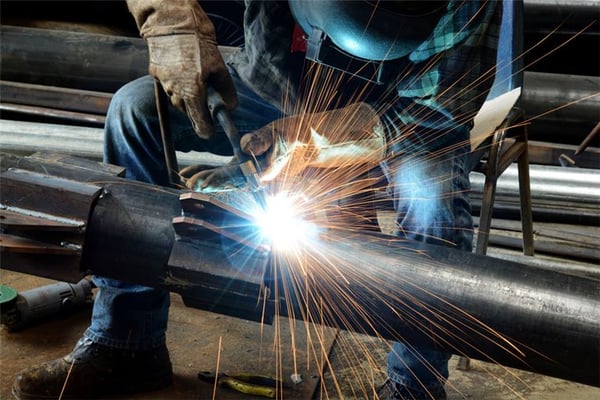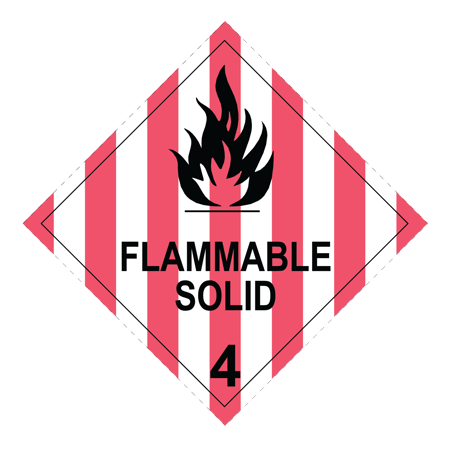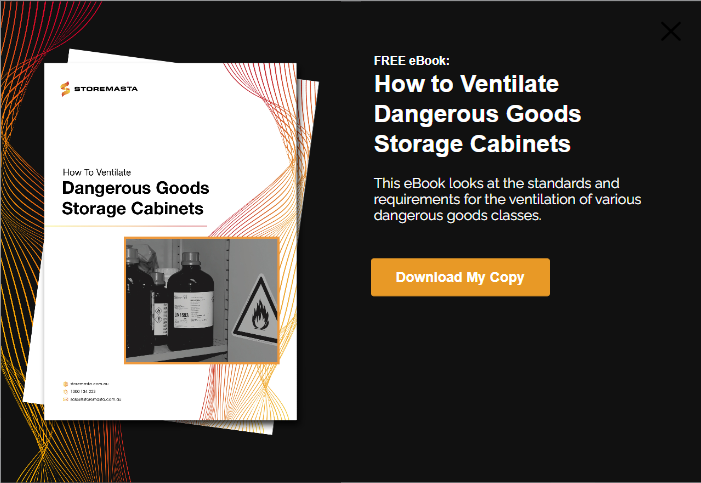If your organisation stores or uses any Class 4 Flammable Solids, it’s important to minimise risk by storing these hazardous goods in a safe and compliant manner. As the name suggests, flammable solids are readily combustible and may cause or contribute to a fire. In this post, we’ll detail some of the key considerations for indoor flammable solids storage, with a focus on mechanical ventilation of these Class 4 Flammable Solid Cabinets.
REMEMBER: As flammable solids are classed as a Division 4.1 dangerous good, refer to the Australian Standard AS/NZS 5026 for full details on their handling and storage.
Understanding Class 4 Dangerous Goods
Flammable solids are recognised as Class 4 Dangerous Goods, and are assigned a specific division which must be understood to ensure safe handling and storage.
Class 4 Dangerous Goods are defined as follows:
Division 4.1 – flammable solids, self-reactive substances and solid desensitized explosives
Solids that, under the conditions of transport, are readily combustible, or may cause or contribute to fire through friction. Self-reactive substances that are liable to undergo a strongly exothermic reaction. Solid desensitized explosives that may explode if not sufficiently diluted.
Division 4.2 – substances liable to spontaneous combustion
- Pyrophoric substances: These include solutions and mixtures (liquid or solid) that, even in small quantities, ignite within 5 minutes of coming in contact with air. These are the division 4.2 substances most liable to spontaneous combustion.
- Self-heating substances: These substances (other than pyrophoric substances) are liable to self-heating. They will ignite only when in large amounts (kg) and after long periods of time (hours or days).
Division 4.3 – substances that, on contact with water, emit flammable gases
Dangerous when wet substances which, in contact with water, can emit flammable gases that can form explosive mixture with air. Such mixtures are easily ignited by all ordinary ignition sources, e.g. naked lights, sparking hand tools, or unprotected light bulbs. The resulting blast wave and flames may endanger people and the environment.
REMEMBER: Class 4 Dangerous Goods, such as flammable solids, are identified by the Class 4 labels (dangerous goods diamond) and Class 4 designation in the product’s safety data sheet.
Hazards Associated with Class 4 Dangerous Goods
As per the description above, Class 4 dangerous and hazardous goods are prone to react, and result in fire. These goods can cause harm to people, property and the environment through fire, explosion and the emission of harmful gases.
Class 4 Dangerous Goods must be handled and stored in such a way as to prevent combustion, dangerous chemical reactions and ignition. We’ll be detailing some of the requirements of flammable solid storage a little later in this post.
REMEMBER: To assist in the reduction of risk with flammable substances, including Division 4.1 Flammable Solids, you must ensure that flammable vapours are controlled within handling and storage areas. This includes allowing for the free flow of air within cabinets, whilst maintaining mechanical ventilation to disperse of the flammable vapours safely.
Safe Storage for Flammable Solids
Some of the key general storage requirements for flammable solids include:
- Exclusion of ignition sources
- Containment of leaks, spills and run-off
- Store construction from non-combustible material resistant to attack by the flammable solids being stored
- Stores secured against unauthorised entry
- Segregation from incompatible substances
- Compliant lighting
- Dangerous goods and hazard placarding
- Adequate natural or mechanical ventilation

Ignition sources must be separated from all Class 4 Dangerous Goods.
Flammable Solids Cabinet Design & Construction
The key storage requirements that apply to the use of indoor flammable solid cabinets includes:
- Double-walled sheet steel construction (walls, floor, door & roof) with thickness of at least 0.75 mm with a space of at least 40 mm between walls. Space to be filled with air or non-combustible insulation.
- Self-closing, close-fitting doors held shut by friction-type or magnetic-type lock to release when there is a build-up of pressure within cabinet.
- Gaps around doors and into space between walls must be sealed to prevent spread of flame or heat radiation.
- Cabinet must have a liquid-tight compound at least 150 mm deep that can contain the contents of the largest container.
- Leakage must be directed into lower spill containment compound.
- Shelving to support maximum load.
- Shelving must be perforated to permit airflow.
IMPORTANT: Due to the magnetic locks on the flammable solids cabinet, we recommend placing the cabinet in a lockable room to prevent unauthorised access.
Ventilation Standards
Whether you’re searching for warehouse ventilation requirements or chemical storage room ventilation requirements, turn to the Australian Standard relevant to your dangerous goods class.
Flammable solids, as a division of Class 4 Dangerous Goods, require storage that adheres to the guidance in the Australian Standard 5026. While this standard covers all Class 4 Dangerous Goods, there are specific instructions for Division 4.1 Flammable Solids in Section 6.
Is Ventilation of Flammable Solids Cabinets Compulsory?
Section 6 of AS/NZS 5026:2012 outlines design requirements for cabinets storing Division 4.1 Flammable Solids and states that “each cabinet or compartment shall be ventilated.”
Therefore, if you were storing 4.1 Flammable Solids, the dangerous goods storage cabinet must be ventilated.
Flammable Solid Cabinet Ventilation Requirements
Safety cabinet ventilation system must be installed in such a way that it doesn’t pose any further risks to the people of your organisation. It’s crucial that the design of any vent opening in the chemical storage cabinet wall must not compromise the structural strength of the cabinet.

Flammable solids may cause a fire or explosion if not stored properly.
When toxic or flammable gases are emitted (such as with Class 4 substances), the ducting must be designed to prevent back-pressure, and directed away from areas where people congregate – as well as ignition sources.
Ventilation systems should only be designed by an appropriately qualified person, such as an engineer.
REMEMBER: Systems for Class 4 cabinet ventilation must comply with AS 166.98.2/NZS 4303. Exhaust air dilution via general exhaust ventilation and local exhaust ventilation are suitable techniques. The extraction system may require a scrubber prior to venting the atmosphere.
Ventilation Requirements for Division 4.2 and 4.3
Not all Class 4 Dangerous Goods require mechanical ventilation of safety cabinets.
If you’re storing Division 4.2 or Division 4.3 Dangerous Goods, ventilation is not mandatory unless the particular substance that you are storing is listed in the workplace exposure standards — and your storage environment has a level of airborne contaminants above the maximum concentration limit.
Considering Workplace Exposure Standards
Exposure to any kind of hazardous substances can pose significant health risks upon your workers. Some of these health risks, depending on the substances and their hazards, may include:
- Asphyxiation
- Vomiting
- Nausea
- Headaches
- Irritation to the eyes, ear and throat
- Dizziness
- Long-term exposure may lead to chronic illness
To help combat these health risks, Safe Work Australia developed the workplace exposure standards. These exposure standards identify hazardous substances and their legal airborne concentration limits.
If your chemicals are listed in the workplace exposure standards —and the concentration of the vapours exceed the limit outlined in this standard — your dangerous goods storage cabinet will require ventilation.
REMEMBER: If you’re unsure about the workplace exposure standards — or concerned about air quality in your workplace —always check with a specialist. Professions including Dangerous Goods Consultants or Occupational Hygienist can assist with matters concerning airborne contaminants or personal airspace monitoring.
Ventilation Standards Australia
The ventilation Standards Australia for flammable solids storage — and other classes and division of dangerous goods — can be found in AS 1668.2/NZS 4303.
As per the information in this ventilation standard, a safe ventilation system must follow a range of requirements.
Flammable solid cabinets require the correct design, construction and installation of a mechanical ventilation system to ensure safety.
These requirements include:
- A mechanical ventilation system of a Class 4 storage unit should be designed so that it prevents any vapours from escaping into the room.
- The ventilation system of a Class 4 storage unit shall be vented to the outside atmosphere in a location that is safe to disperse vapours. A safe location will be away from ignition sources and places where people congregate.
- The air inlet shall be attached to the vent port at the top of the cabinet and the vapours shall be extracted from the bottom vent port using an exhaust fan. This configuration is most effective as most flammable vapours are heavier than air and reside in the bottom of the cabinet.
- Any ventilation system that is used to extract flammable vapours will need to have an intrinsically safe exhaust fan.
- A ventilation system cannot be linked to multiple cabinets. This can cause incompatible vapours to mix, resulting in violent reactions.
- When a mechanical ventilation system is not attached to a cabinet, the vent bungs must be tightly screwed into the vent ports. This stops any flammable vapours from escaping into the workplace.
- In all instances the ventilation system shall not compromise the structural integrity of the cabinet.
- In all cases the ventilation duct shall not be smaller than the size of the venting opening on the side of the cabinet.
- A Class 4 dangerous goods ventilation system shall be designed by an appropriately qualified engineer
- The system must comply with AS/NZS -1668.2-2002
Like to Learn More About the Ventilation of Dangerous Goods Cabinets?
As flammable substances are very susceptible to reaction, particularly combustion, it is very important that Class 4 dangerous goods storage cabinets are ventilated appropriately and compliantly according to Australian Standard AS/NZS – 1668.2-2002, with storage adhering to the requirements of AS/NZS 5026:2012.
For more detained information and specifications on how to ventilate dangerous goods storage cabinets, you can access our free eBook. This helpful guide will help you understand the requirements that apply to the ventilation of indoor chemical storage cabinets. Get your copy now to find out more.

Living life by the 4 C’s of marketing – communication, coffee, compliance… and more coffee – Leisa Andersen is Storemasta’s Content Marketing Manager. When she’s not writing, you’ll find her enjoying all the good things in life, including shopping, travel and gluten free donuts.
